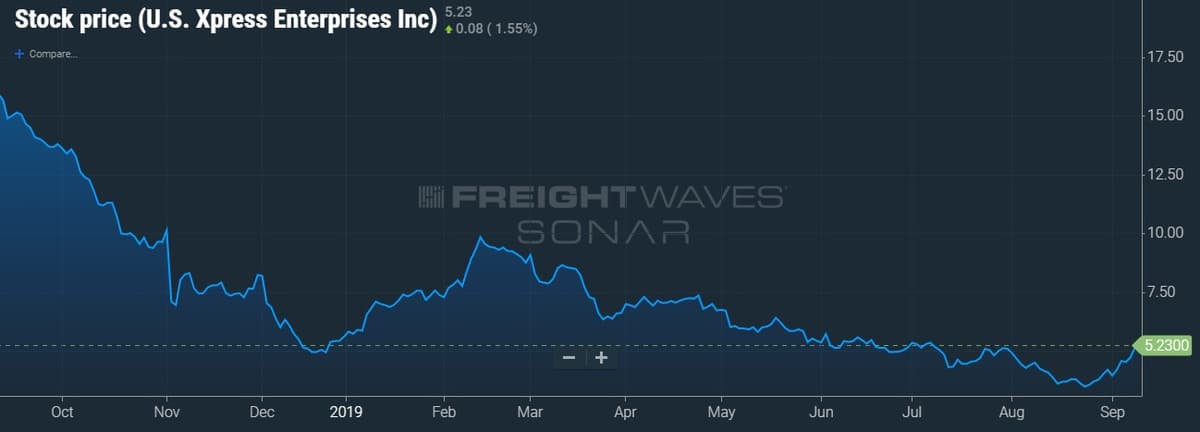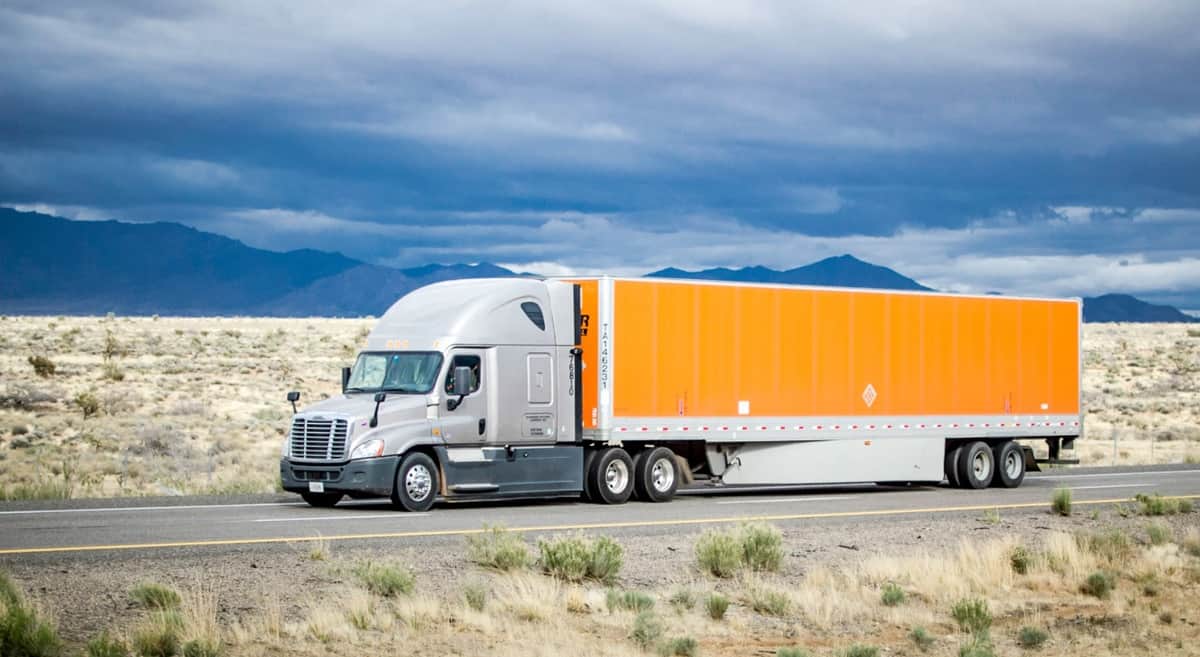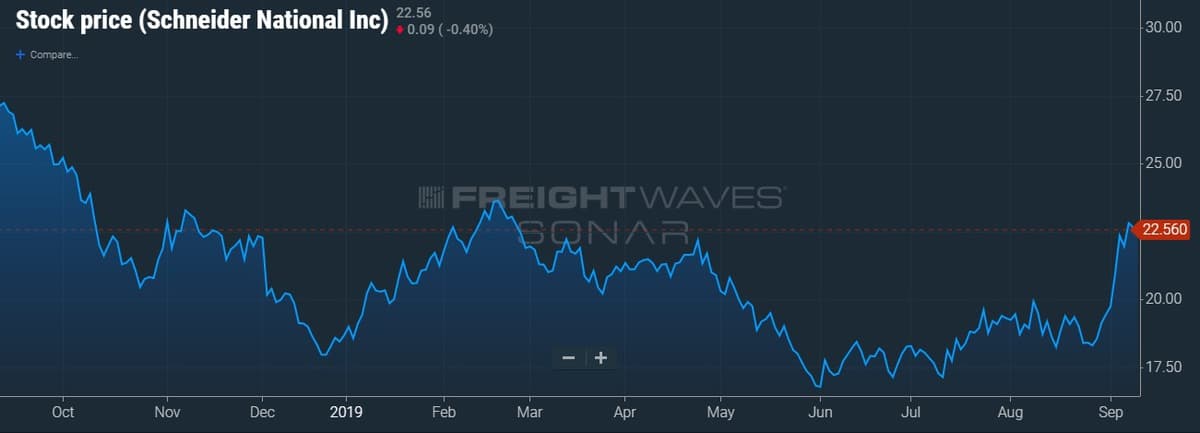Two of the nation’s largest truckload (TL) carriers indicated they are seeing green shoots in freight demand in separate presentations at the Morgan Stanley 7th Annual Laguna Conference.
President and CEO Eric Fuller represented U.S. Xpress (NYSE: USX) with CEO Mark Rourke and chief financial officer Stephen Bruffett doing the bidding for Schneider National (NYSE: SNDR).
Current TL market trends
U.S. Xpress’ Fuller said he sees “some life.” He said that over the last eight to 10 weeks conditions have been a “little better everywhere,” making specific reference to improvement on the west coast. Fuller said that most of the retailers they serve are “seeing fairly robust sales” and that nothing that they have heard from their customers suggests a looming recession even though some macroeconomic data suggests otherwise. He expects “a little more of a normal peak this year,” but thinks that tariff talk has clouded the picture some over the last 18 months.
Schneider National’s Rourke said that they are seeing an improving freight market with more traditional seasonality. He said that the improvement in both its for-hire TL and intermodal divisions began in the second half of August with traditional seasonal demand continuing into September. Rourke cautioned that the recent uptick in demand hasn’t rivaled the robust levels seen in 2018, but noted that they are pleased to see a return to more typical seasonality heading into peak shipping season.
Rourke said that the last six to seven days were the “busiest” of the year for intermodal, most notably in the west. When pressed if this was an inventory pull forward similar to what was seen ahead of last year’s tariff concerns, he said that Schneider hasn’t seen evidence of that. They believe it was more indicative of normal seasonality.
On future capacity limiting events
Rourke sees several favorable catalysts that will likely restrict the amount of future available TL capacity. He said that the recent spike in bankruptcies and/or carrier failures from the “marginal players” will help ease the impacts of an oversupplied market.
Fuller said that he believes that depressed spot rates will continue to force carriers out of the industry and anecdotally made reference to carriers filing for bankruptcy and turning their trucks over to the lenders.
The two diverged on the likely effects of the mandate requiring a switch from automatic onboard recording devices (AOBRDs) to electronic logging devices (ELDs). Rourke believes that this will likely be the most restrictive event the industry faces in the near-term.
Fuller said he doesn’t believe that the mandate to switch to ELDs will force many carriers to leave the industry. He called out the implementation of a national drug and alcohol clearinghouse, which will use hair testing in lieu of urine analysis for drug testing, as the event that would most affect capacity.
“Nothing’s bigger than the drug and alcohol clearinghouse, I think it’s more impactful than ELDs.” Fuller thinks that over a 12-month period after implementation many drivers could leave the industry. He speculated that as much as 10% of the driving population could be affected. However, Fuller said he would be surprised if hair follicle testing was mandated in the next 10 years.
Both were in agreement on IMO 2020 regulation. The capping of sulfur content in marine fuels will likely increase demand for distillate fuel and raise the price of diesel, but neither believe this will have any real impact on TL capacity. It will likely provide a fuel cost headwind for TL carriers, but not necessarily a meaningful catalyst to leave the industry.
TL Rates
Fuller wasn’t ready to make a specific call on 2020 rates, but thinks they will be positive. Most of U.S. Xpress’ contracts have already been renegotiated in 2019. He expects flat pricing on contracts that will be renewed between now and the end of the year, with 2019 in sum, producing contractual rate increases in the low single-digit range on a year-over-year comparison.
Rourke believes that the cumulative impact of capacity tightening events will produce contractual TL pricing that is flat to slightly higher year-over-year in 2020.
Spot market exposure
Both carriers were plagued financially in the first half of 2019 with excess exposure to significantly lower rates in the spot market.
Schneider’s spot market exposure is down to five percent to seven percent in its one-way TL division. That’s well off the levels seen at the beginning of the year when the carrier entered 2019 overexposed to the spot market. Additionally, the carrier attempted to keep recently hired drivers onboard by accepting poorly margined freight in the spot market, exacerbating the issue. Currently, the company’s spot market exposure is within its historical norms.
Spot freight is usually 10% of U.S. Xpress’ total revenue. When the carrier divested its operation in Mexico, a large fixed cost network, it was left trying to re-position roughly 300 trucks. Most of these ended up in the spot market where rates were significantly lower than what the company was receiving on for-hire contractual freight. U.S. Xpress saw spot exposure climb as high as 15% of total revenue in some weeks. Now, Fuller believes that the company is “still probably a little overexposed to spot than we would like, but it takes time when the market is weaker than we would like to work through that.”
Retailers insourcing transportation and logistics
When asked about large e-commerce retailers acquiring their own equipment and approaching the railroads directly to contract intermodal shipments, Rourke said that there are a few players that have the scale to do this, but that this isn’t likely to be an “across the board” solution. Rourke was asked if the larger retailers that have shown a desire to insource their transportation needs have talked of pulling freight away from the carrier, he said that this hasn’t been the case.
Fuller said that U.S. Xpress has seen one customer move to insourcing, but that no one is meaningfully scaling back their dedicated needs from the carrier and moving transportation in-house.
Company specific – U.S. Xpress
Fuller expects the market to come back over the next couple of quarters and said that the cycle is playing out as expected. He said the company remains focused on improving operations and lowering costs. One of the biggest cost levers the carrier has is the insurance and claims line. Fuller said that the implementation of forward looking event recorders is producing fewer accidents on a per million mile basis, a trend that has held over the last 10 weeks. He believes that this will eventually begin to show in the form of reduced insurance costs.
Frictionless order is another initiative for the carrier. Fuller explained that there are 15 touch points in the order process that require manual entry, human involvement and decisions to be made. He said that at each gateway there is inefficiency, misinformation and poor decision making. He believes that the bulk of these gateways can be automated, increasing efficiency and lowering costs. Frictionless order is also expected to help the carrier in driver retention efforts.
When asked if the 93% operating ratio (OR) target was still achievable over time, Fuller said he does. The company’s excess exposure to the spot market required the target to be taken off the table earlier in the year. He went on to say that in a mid-cycle market, a 90% to 92% OR “is very, very achievable.”

Company specific – Schneider National
Rourke said that Schneider can grow its intermodal business without adding incremental investment. He said that the work the company has done acquiring containers, up 28%, and chassis will help on the cost side of the equation. 2018 intermodal margins were in the 12% to 13%-plus range, but have moderated a bit, closer to 10% to 12% currently. Bruffett said that the current level is likely a reasonable expectation for intermodal margins longer term.

Rourke acknowledged the recent closure of the company’s First to Final Mile (FTFM) service offering. He said it was the right move. Schneider’s FTFM network consisted of 26 leased terminal locations with nationwide service for business-to-business and business-to-consumer movements of household durable goods. The company is expected to incur pre-tax restructuring charges of $50 million to $75 million due to the closure after already recording a $34.6 million goodwill impairment recorded in second quarter 2019.
While management wasn’t doing a victory lap over the successful closure of the business (expected to be completed in the third quarter 2019), they indicated that the company’s operations will become more profitable in 2020 as the year-over-year comparisons will not have to contend with the headwind ($35 million year-to-date loss from FTFM). Additionally, the carrier won’t likely see the earnings drags associated with its overexposure to the spot market and carrying excess driver capacity like it saw in the beginning of 2019. However, incentive compensation will likely be a headwind in 2020 compared to the company’s financial underperformance in 2019.












